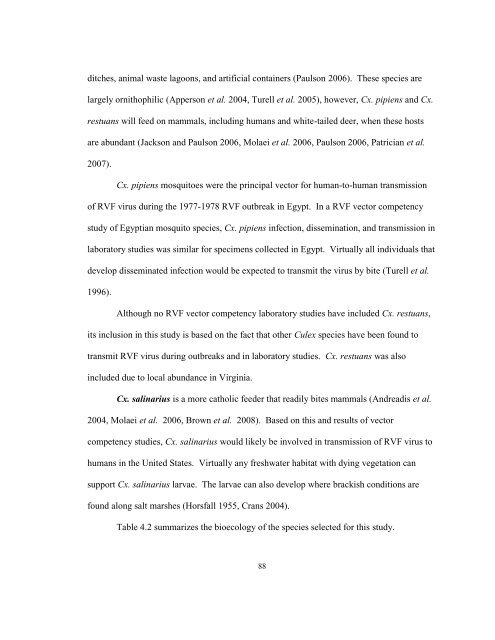Sample A: Cover Page of Thesis, Project, or Dissertation Proposal
Sample A: Cover Page of Thesis, Project, or Dissertation Proposal
Sample A: Cover Page of Thesis, Project, or Dissertation Proposal
Create successful ePaper yourself
Turn your PDF publications into a flip-book with our unique Google optimized e-Paper software.
ditches, animal waste lagoons, and artificial containers (Paulson 2006). These species are<br />
largely <strong>or</strong>nithophilic (Apperson et al. 2004, Turell et al. 2005), however, Cx. pipiens and Cx.<br />
restuans will feed on mammals, including humans and white-tailed deer, when these hosts<br />
are abundant (Jackson and Paulson 2006, Molaei et al. 2006, Paulson 2006, Patrician et al.<br />
2007).<br />
Cx. pipiens mosquitoes were the principal vect<strong>or</strong> f<strong>or</strong> human-to-human transmission<br />
<strong>of</strong> RVF virus during the 1977-1978 RVF outbreak in Egypt. In a RVF vect<strong>or</strong> competency<br />
study <strong>of</strong> Egyptian mosquito species, Cx. pipiens infection, dissemination, and transmission in<br />
lab<strong>or</strong>at<strong>or</strong>y studies was similar f<strong>or</strong> specimens collected in Egypt. Virtually all individuals that<br />
develop disseminated infection would be expected to transmit the virus by bite (Turell et al.<br />
1996).<br />
Although no RVF vect<strong>or</strong> competency lab<strong>or</strong>at<strong>or</strong>y studies have included Cx. restuans,<br />
its inclusion in this study is based on the fact that other Culex species have been found to<br />
transmit RVF virus during outbreaks and in lab<strong>or</strong>at<strong>or</strong>y studies. Cx. restuans was also<br />
included due to local abundance in Virginia.<br />
Cx. salinarius is a m<strong>or</strong>e catholic feeder that readily bites mammals (Andreadis et al.<br />
2004, Molaei et al. 2006, Brown et al. 2008). Based on this and results <strong>of</strong> vect<strong>or</strong><br />
competency studies, Cx. salinarius would likely be involved in transmission <strong>of</strong> RVF virus to<br />
humans in the United States. Virtually any freshwater habitat with dying vegetation can<br />
supp<strong>or</strong>t Cx. salinarius larvae. The larvae can also develop where brackish conditions are<br />
found along salt marshes (H<strong>or</strong>sfall 1955, Crans 2004).<br />
Table 4.2 summarizes the bioecology <strong>of</strong> the species selected f<strong>or</strong> this study.<br />
88




![[Sample B: Approval/Signature Sheet] - George Mason University](https://img.yumpu.com/21978828/1/190x245/sample-b-approval-signature-sheet-george-mason-university.jpg?quality=85)


![[Sample B: Approval/Signature Sheet] - George Mason University](https://img.yumpu.com/18694905/1/190x245/sample-b-approval-signature-sheet-george-mason-university.jpg?quality=85)






![[Sample B: Approval/Signature Sheet] - George Mason University](https://img.yumpu.com/18694552/1/189x260/sample-b-approval-signature-sheet-george-mason-university.jpg?quality=85)


![[Sample B: Approval/Signature Sheet] - George Mason University](https://img.yumpu.com/18694474/1/190x245/sample-b-approval-signature-sheet-george-mason-university.jpg?quality=85)